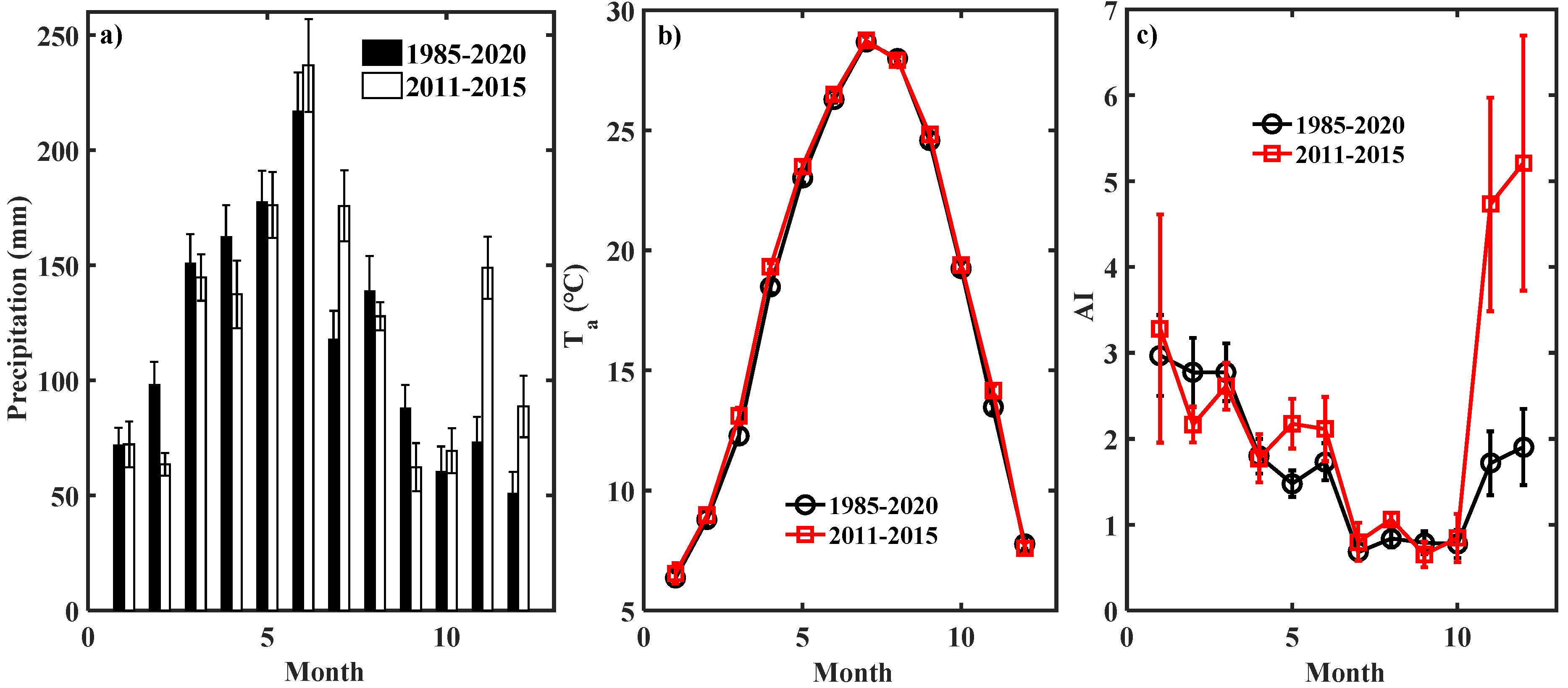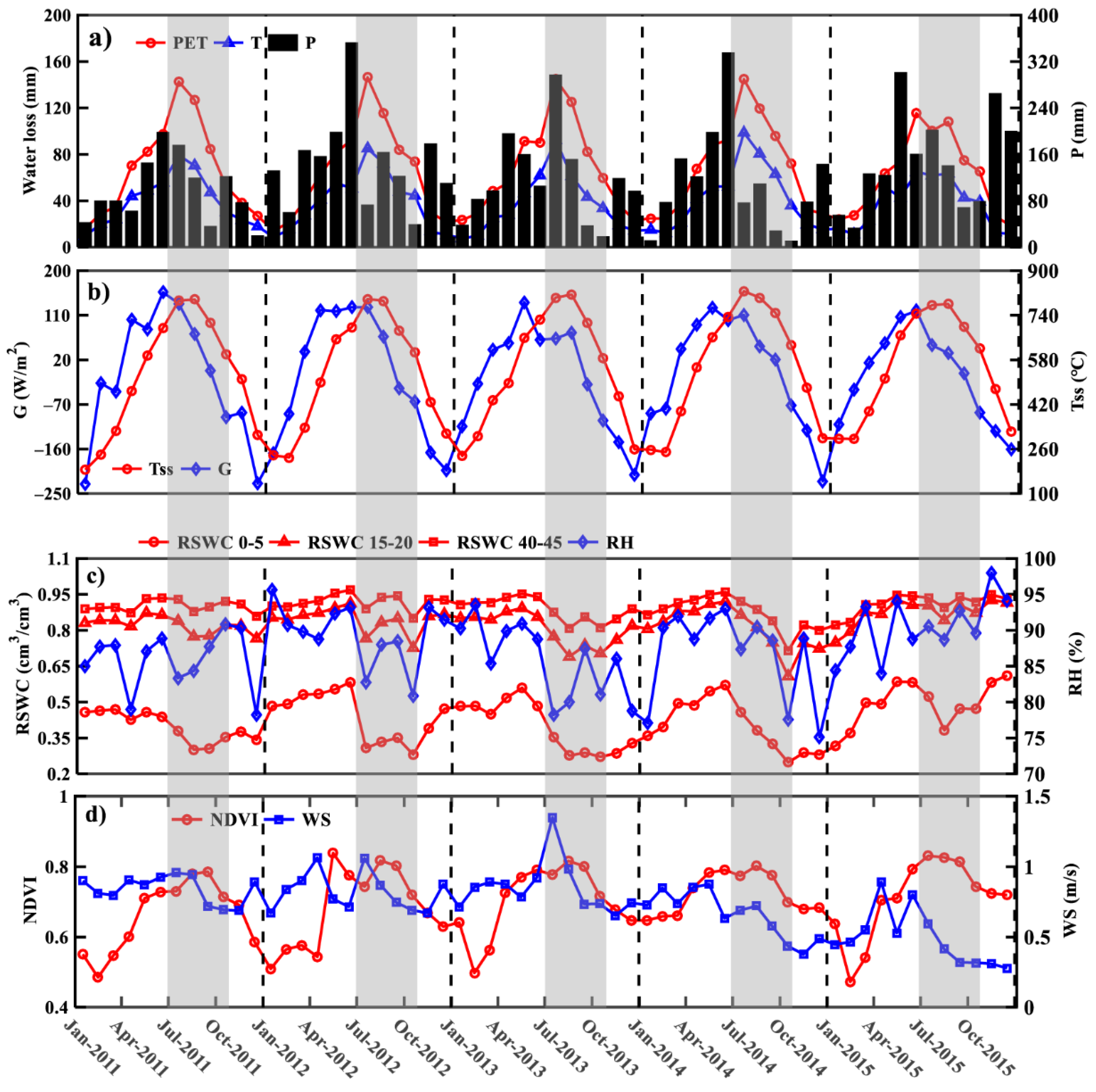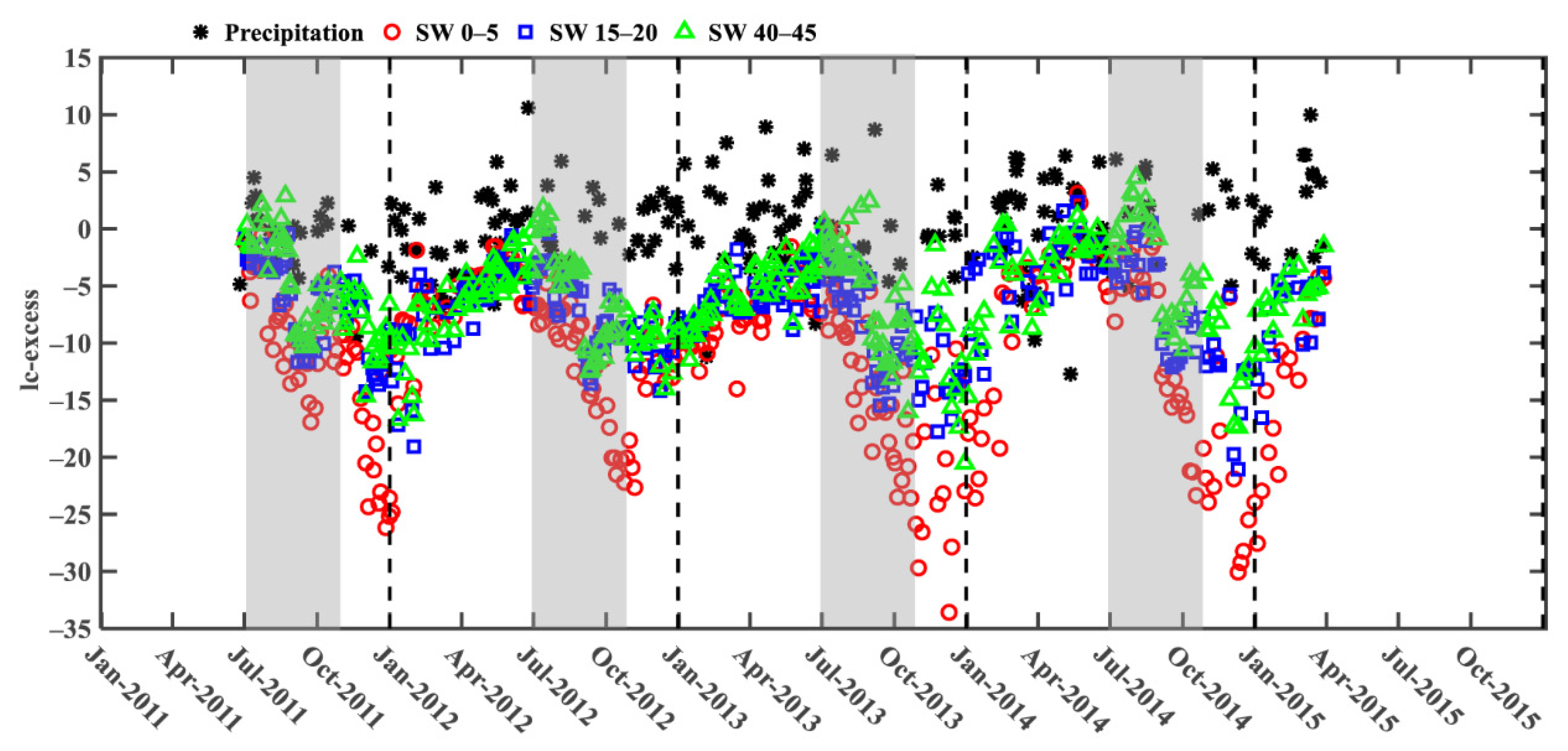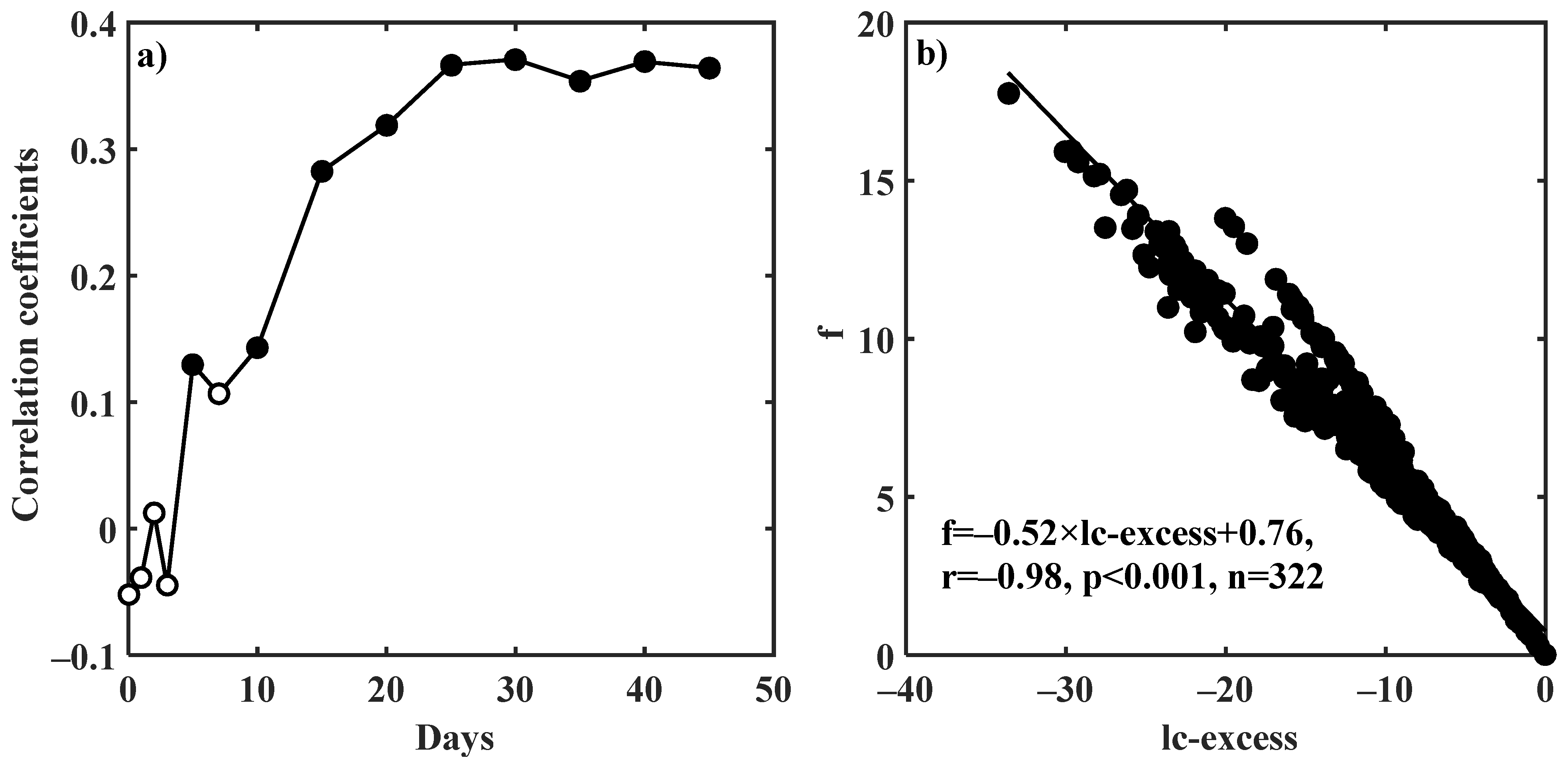Soil Water Stable Isotopes Reveal Surface Soil Evaporation Loss Dynamics in a Subtropical Forest Plantation
Abstract
:1. Introduction
2. Materials and Methods
2.1. Study Site
2.2. Division of Drought and Non-Drought Periods
2.3. Sampling Collection and Measurements
2.4. Calculations of Lc-Excess and Soil Evaporation Loss Fraction
2.5. Ancillary Indicator Measurements
2.6. Statistical Analyses
3. Results
3.1. Seasonal Variability of Climate, Soil and Vegetation
3.2. Seasonal Variability in Lc-Excess of Precipitation and Soil Water
3.3. Influencing Factors of Temporal Variation in Lc-Excess of Soil Water
3.4. Soil Water Evaporation Loss Fraction
4. Discussion
4.1. Capacity of Lc-Excess to Indicate Surface Soil Evaporation Loss
4.2. Interaction Effects of Climate, Soil and Vegetation on Temporal Variation in Lc-Excess
5. Conclusions
Supplementary Materials
Author Contributions
Funding
Institutional Review Board Statement
Informed Consent Statement
Data Availability Statement
Acknowledgments
Conflicts of Interest
References
- Hirschi, M.; Seneviratne, S.I.; Alexandrov, V.; Boberg, F.; Boroneant, C.; Christensen, O.B.; Formayer, H.; Orlowsky, B.; Stepanek, P. Observational evidence for soil-moisture impact on hot extremes in southeastern Europe. Nat. Geosci. 2011, 4, 17–21. [Google Scholar] [CrossRef]
- McColl, K.A.; Alemohammad, S.H.; Akbar, R.; Konings, A.G.; Yueh, S.; Entekhabi, D. The global distribution and dynamics of surface soil moisture. Nat. Geosci. 2017, 10, 100–104. [Google Scholar] [CrossRef]
- Kool, D.; Agam, N.; Lazarovitch, N.; Heitman, J.L.; Sauer, T.J.; Ben-Gal, A. A review of approaches for evapotranspiration partitioning. Agric. For. Meteorol. 2014, 184, 56–70. [Google Scholar] [CrossRef]
- Skrzypek, G.; Mydlowski, A.; Dogramaci, S.; Hedley, P.; Gibson, J.J.; Grierson, P.F. Estimation of evaporative loss based on the stable isotope composition of water using Hydrocalculator. J. Hydrol. 2015, 523, 781–789. [Google Scholar] [CrossRef] [Green Version]
- Alexander, L. Extreme heat rooted in dry soils. Nat. Geosci. 2010, 4, 12–13. [Google Scholar] [CrossRef]
- Taikan, O.; Shinjiro, K. Global hydrological cycles and world water resources. Science 2006, 313, 1068–1072. [Google Scholar]
- Landwehr, J.M.; Coplen, T.B. Line-conditioned excess: A new method for characterizing stable hydrogen and oxygen isotope ratios in hydrologic systems. In Proceedings of the International Atomic Energy Agency, Vienna, Austria, 25–29 October 2006. [Google Scholar]
- Sprenger, M.; Leistert, H.; Gimbel, K.; Weiler, M. Illuminating hydrological processes at the soil-vegetation-atmosphere interface with water stable isotopes. Rev. Geophys. 2016, 54, 674–704. [Google Scholar] [CrossRef] [Green Version]
- Sprenger, M.; Tetzlaff, D.; Soulsby, C. Soil water stable isotopes reveal evaporation dynamics at the soil-plant-atmosphere interface of the critical zone. Hydrol. Earth Syst. Sci. 2017, 21, 3839–3858. [Google Scholar] [CrossRef] [Green Version]
- Ellsworth, P.Z.; Williams, D.G. Hydrogen isotope fractionation during water uptake by woody xerophytes. Plant Soil 2007, 291, 93–107. [Google Scholar] [CrossRef]
- Zhao, Y.; Wang, L. Plant water use strategy in response to spatial and temporal variation in precipitation patterns in China: A stable isotope analysis. Forests 2018, 9, 123. [Google Scholar] [CrossRef] [Green Version]
- Mu, Y.; Wang, D.; Wang, Y. Importance of temporal scale in assessing changes in soil-water storage in apple orchards on the Chinese Loess Plateau. Forests 2020, 11, 793. [Google Scholar] [CrossRef]
- Xiang, W.; Si, B.; Li, M.; Li, H.; Lu, Y.; Zhao, M.; Feng, H. Stable isotopes of deep soil water retain long-term evaporation loss on China’s Loess Plateau. Sci. Total Environ. 2021, 784, 147153. [Google Scholar] [CrossRef] [PubMed]
- Todd, R.W.; Evett, S.R.; Howell, T.A.; Klocke, N.L. Soil temperature and water evaporation of small steel and plastic lysimeters replaced daily. Soil Sci. 2000, 165, 890–895. [Google Scholar] [CrossRef]
- Raz-Yaseef, N.; Rotenberg, E.; Yakir, D. Effects of spatial variations in soil evaporation caused by tree shading on water flux partitioning in a semi-arid pine forest. Agric. For. Meteorol. 2010, 150, 454–462. [Google Scholar] [CrossRef]
- Baldocchi, D.D. How eddy covariance flux measurements have contributed to our understanding of Global Change Biology. Glob. Chang. Biol. 2020, 26, 242–260. [Google Scholar] [CrossRef] [PubMed]
- Domec, J.C.; Sun, G.; Noormets, A.; Gavazzi, M.J.; Treasure, E.A.; Cohen, E.; Swenson, J.J.; McNulty, S.G.; King, J.S. A comparison of three methods to estimate evapotranspiration in two contrasting lob lolly pine plantations: Age-related changes in water use and drought sensitivity of evapotranspiration components. For. Sci. 2012, 58, 497–512. [Google Scholar]
- Yunusa, I.A.M.; Walker, R.R.; Lu, P. Evapotranspiration components from energy balance, sapflow and microlysimetry techniques for an irrigated vineyard in inland Australia. Agric. For. Meteorol. 2004, 127, 93–107. [Google Scholar] [CrossRef]
- Sprenger, M.; Tetzlaff, D.; Buttle, J.; Carey, S.K.; McNamara, J.P.; Laudon, H.; Shatilla, N.J.; Soulsby, C. Storage, mixing, and fluxes of water in the critical zone across northern environments inferred by stable isotopes of soil water. Hydrol. Process. 2018, 32, 1720–1737. [Google Scholar] [CrossRef] [Green Version]
- Dai, J.J.; Zhang, X.P.; Luo, Z.D.; Wang, R.; Liu, Z.L.; He, X.G.; Rao, Z.G.; Guan, H.D. Variation of the stable isotopes of water in the soil-plant-atmosphere continuum of a Cinnamomum camphora woodland in the East Asian monsoon region. J. Hydrol. 2020, 589, 125199. [Google Scholar] [CrossRef]
- Hasselquist, N.J.; Benegas, L.; Roupsard, O.; Malmer, A.; Ilstedt, U. Canopy cover effects on local soil water dynamics in a tropical agroforestry system: Evaporation drives soil water isotopic enrichment. Hydrol. Process. 2018, 32, 994–1004. [Google Scholar] [CrossRef]
- Kayler, Z.E.; Bredoire, F.; McMillan, H.; Barsukov, P.A.; Rusalimova, O.; Nikitich, P.; Bakker, M.R.; Zeller, B.; Fontaine, S.; Derrien, D. Soil evaporation and organic matter turnover in the Sub-Taiga and Forest-Steppe of southwest Siberia. Sci. Rep. 2018, 8, 10904. [Google Scholar] [CrossRef] [Green Version]
- Lyu, S.; Wang, J.; Song, X.; Wen, X. The relationship of δD and δ18O in surface soil water and its implications for soil evaporation along grass transects of Tibet, Loess, and Inner Mongolia Plateau. J. Hydrol. 2021, 600, 126533. [Google Scholar] [CrossRef]
- Or, D.; Lehmann, P.; Shahraeeni, E.; Shokri, N. Advances in soil evaporation physics A review. Vadose Zone J. 2013, 12, vzj2012.0163. [Google Scholar] [CrossRef]
- Gaj, M.; McDonnell, J.J. Possible soil tension controls on the isotopic equilibrium fractionation factor for evaporation from soil. Hydrol. Process. 2019, 33, 1629–1634. [Google Scholar] [CrossRef]
- Feng, Y.; Qiu, G.Y.; Zhang, Q. Determination of canopy-shadow-affected area in sparse steppes and its effects on evaporation and evapotranspiration. Ecohydrology 2014, 7, 1589–1603. [Google Scholar] [CrossRef]
- Yang, B.; Wen, X.; Sun, X. Seasonal variations in depth of water uptake for a subtropical coniferous plantation subjected to drought in an East Asian monsoon region. Agric. For. Meteorol. 2015, 201, 218–228. [Google Scholar] [CrossRef]
- Sun, X.; Wen, X.; Yu, G.; Liu, Y.; Liu, Q. Seasonal drought effects on carbon sequestration of a mid-subtropical planted forest of southeastern China. Sci. China Ser. D Earth Sci. 2006, 49, 110–118. [Google Scholar] [CrossRef]
- Wen, X.F.; Wang, H.M.; Wang, J.L.; Yu, G.R.; Sun, X.M. Ecosystem carbon exchanges of a subtropical evergreen coniferous plantation subjected to seasonal drought, 2003–2007. Biogeosciences 2010, 7, 357–369. [Google Scholar] [CrossRef] [Green Version]
- Wen, X.F.; Yu, G.R.; Sun, X.M.; Li, Q.K.; Liu, Y.F.; Zhang, L.M.; Ren, C.Y.; Fu, Y.L.; Li, Z.Q. Soil moisture effect on the temperature dependence of ecosystem respiration in a subtropical Pinus plantation of southeastern China. Agric. For. Meteorol. 2006, 137, 166–175. [Google Scholar] [CrossRef]
- Tang, Y.K.; Wen, X.F.; Sun, X.M.; Zhang, X.Y.; Wang, H.M. The limiting effect of deep soil water on evapotranspiration of a subtropical coniferous plantation subjected to seasonal drought. Adv. Atmos. Sci. 2014, 31, 385–395. [Google Scholar] [CrossRef]
- Yu, G.; Chen, Z.; Piao, S.; Peng, C.; Ciais, P.; Wang, Q.; Li, X.; Zhu, X. High carbon dioxide uptake by subtropical forest ecosystems in the East Asian monsoon region. Proc. Natl. Acad. Sci. USA 2014, 111, 4910–4915. [Google Scholar] [CrossRef] [PubMed] [Green Version]
- Song, X.; Lyu, S.; Wen, X. Limitation of soil moisture on the response of transpiration to vapor pressure deficit in a subtropical coniferous plantation subjected to seasonal drought. J. Hydrol. 2020, 591, 125301. [Google Scholar] [CrossRef]
- Song, X.W.; Lyu, S.D.; Sun, K.; Gao, Y.; Wen, X.F. Flux and source of dissolved inorganic carbon in a headwater stream in a subtropical plantation catchment. J. Hydrol. 2021, 600, 126511. [Google Scholar]
- Yang, F.; Feng, Z.; Wang, H.; Dai, X.; Fu, X. Deep soil water extraction helps to drought avoidance but shallow soil water uptake during dry season controls the inter-annual variation in tree growth in four subtropical plantations. Agric. For. Meteorol. 2017, 234, 106–114. [Google Scholar] [CrossRef]
- West, A.G.; Patrickson, S.J.; Ehleringer, J.R. Water extraction times for plant and soil materials used in stable isotope analysis. Rapid Commun. Mass Spectrom. 2006, 20, 1317–1321. [Google Scholar] [CrossRef]
- Wen, X.; Lee, X.; Sun, X.; Wang, J.; Tang, Y.; Li, S.; Yu, G. Intercomparison of four commercial analyzers for water vapor isotope measurement. J. Atmos. Ocean. Technol. 2012, 29, 235–247. [Google Scholar] [CrossRef] [Green Version]
- Nelson, D.B.; Basler, D.; Kahmen, A. Precipitation isotope time series predictions from machine learning applied in Europe. Proc. Natl. Acad. Sci. USA 2021, 118, e2024107118. [Google Scholar] [CrossRef]
- Gibson, J.J.; Birks, S.J.; Edwards, T.W.D. Global prediction of δA and δ2H-δ18O evaporation slopes for lakes and soil water accounting for seasonality. Glob. Biogeochem. Cycles 2008, 22, GB2031. [Google Scholar] [CrossRef]
- Horita, J.; Wesolowski, D.J. Liquid-vapor fractionation of oxygen and hydrogen isotopes of water from the freezing to the critical-temperature. Geochim. Cosmochim. Acta 1994, 58, 3425–3437. [Google Scholar] [CrossRef]
- Benettin, P.; Volkmann, T.H.M.; von Freyberg, J.; Frentress, J.; Penna, D.; Dawson, T.E.; Kirchner, J. Effects of climatic seasonality on the isotopic composition of evaporating soil waters. Hydrol. Earth Syst. Sci. 2018, 22, 2881–2890. [Google Scholar] [CrossRef] [Green Version]
- Zhang, Y.G.; Schaap, M.G. Weighted recalibration of the rosetta pedotransfer model with improved estimates of hydraulic parameter distributions and summary statistics (Rosetta3). J. Hydrol. 2017, 547, 39–53. [Google Scholar] [CrossRef] [Green Version]
- Allen, R.G.; Pereira, L.S.; Raes, D.; Smith, M. Crop Evapotranspiration Guidelines for Computing Crop Water Requirements-FAO Irrigation and Drainage Paper 56; FAO: Rome, Italy, 1998. [Google Scholar]
- Hu, H.; Chen, L.; Liu, H.; Khan, M.Y.A.; Tie, Q.; Zhang, X.; Tian, F. Comparison of the vegetation effect on ET partitioning based on eddy covariance method at five different sites of northern China. Remote Sens. 2018, 10, 1755. [Google Scholar] [CrossRef] [Green Version]
- Liu, J.; Wu, H.; Cheng, Y.; Jin, Z.; Hu, J. Stable isotope analysis of soil and plant water in a pair of natural grassland and understory of planted forestland on the Chinese Loess Plateau. Agric. Water Manag. 2021, 249, 106800. [Google Scholar] [CrossRef]
- Hervé-Fernández, P.; Oyarzún, C.; Brumbt, C.; Huygens, D.; Bodé, S.; Verhoest, N.E.C.; Boeckx, P. Assessing the “two water worlds” hypothesis and water sources for native and exotic evergreen species in south-central Chile. Hydrol. Process. 2016, 30, 4227–4241. [Google Scholar] [CrossRef]
- Lyu, S.D.; Song, X.W.; Wen, X.F. Ecohydrologic separation of the mixing process between precipitation and soil water: A review. J. Appl. Ecol. 2019, 30, 1797–1806. [Google Scholar]
- Wei, H.; He, H.; Liu, M.; Zhang, L.; Yu, G.R.; Min, C.; Wang, H.; Lyu, Y. Modeling evapotranspiration and its components in Qianyanzhou plantation based on remote sensing data. J. Nat. Resour. 2012, 27, 778–789. (In Chinese) [Google Scholar]
- Rothfuss, Y.; Merz, S.; Vanderborght, J.; Hermes, N.; Weuthen, A.; Pohlmeier, A.; Vereecken, H.; Brüggemann, N. Long-term and high-frequency non-destructive monitoring of water stable isotope profiles in an evaporating soil column. Hydrol. Earth Syst. Sci. 2015, 19, 4067–4080. [Google Scholar] [CrossRef] [Green Version]
- Green, J.K.; Konings, A.G.; Alemohammad, S.H.; Berry, J.; Entekhabi, D.; Kolassa, J.; Lee, J.-E.; Gentine, P. Regionally strong feedbacks between the atmosphere and terrestrial biosphere. Nat. Geosci. 2017, 10, 410–414. [Google Scholar] [CrossRef] [PubMed]






| Classify | 7 Days | 15 Days | 30 Days | ||||||
|---|---|---|---|---|---|---|---|---|---|
| Multiple Linear Model | Whole Year (n = 335) | Non-Drought Periods (n = 193) | Drought Periods (n = 142) | Whole Year (n = 335) | Non-Drought Periods (n = 193) | Drought Periods (n = 142) | Whole Year (n = 335) | Non-Drought Periods (n = 193) | Drought Periods (n = 142) |
| Multiple r2 (adjusted) | 0.737 | 0.752 | 0.747 | 0.732 | 0.764 | 0.715 | 0.688 | 0.719 | 0.687 |
| RH | 0.337 (20.5%) | 0.233 (18.9%) | 0.325 (17.2%) | 0.434 (22.4%) | 0.365 (24.6%) | 0.448 (23%) | 0.399 (17.7%) | 0.310 (21.8%) | 0.402 (22.2%) |
| WS | 0.185 (11.2%) | 0.096 (7.8%) | 0.372 (19.7%) | 0.217 (11.2%) | 0.140 (9.4%) | 0.463 (23.8%) | 0.174 (7.7%) | n.s. | 0.437 (24.2%) |
| RSWC 0–5 | 0.368 (22.3%) | 0.444 (36%) | 0.367 (19.4%) | 0.177 (9.1%) | 0.188 (12.7%) | 0.282 (14.5%) | 0.102 (4.5%) | 0.222 (15.6%) | 0.302 (16.7%) |
| Tss 0–5 | n.s. | n.s. | 0.511 (27%) | −0.237(12.3%) | −0.205 (13.8%) | 0.406 (20.9%) | −0.608 (27%) | −0.285 (20.1%) | 0.343 (19%) |
| G | 0.332 (20.1%) | 0.378 (30.7%) | n.s. | 0.464 (24%) | 0.588 (39.6%) | n.s. | 0.545 (24.2%) | 0.605 (42.5%) | n.s. |
| T | 0.280 (17%) | n.s. | n.s. | 0.294 (15.2%) | n.s. | n.s. | 0.425 (18.9%) | n.s. | n.s. |
| NDVI | −0.146 (8.8%) | −0.081 (6.6%) | −0.315 (16.7%) | −0.11 (5.7%) | n.s. | −0.347 (17.8%) | n.s. | n.s. | −0.323 (17.9%) |
| R | lc-Excess | P | RH | WS | RSWC 0–5 | Tss | G | T | NDVI |
|---|---|---|---|---|---|---|---|---|---|
| 7 Days (Whole Year) | |||||||||
| lc-excess | 1.000 | 0.298 ** | 0.414 ** | 0.307 ** | 0.656 ** | 0.332 ** | 0.665 ** | 0.386 ** | 0.165 ** |
| P | 0.298 ** | 1.000 | 0.339 ** | 0.080 | 0.360 ** | 0.140 * | 0.167 ** | 0.047 | 0.149 ** |
| RH | 0.414 ** | 0.339 ** | 1.000 | −0.321 ** | 0.521 ** | −0.023 | 0.065 | −0.267 ** | 0.017 |
| WS | 0.307 ** | 0.080 | −0.321 ** | 1.000 | 0.047 | 0.267 ** | 0.305 ** | 0.468 ** | 0.131 * |
| RSWC 0–5 | 0.656 ** | 0.360 ** | 0.521 ** | 0.047 | 1.000 | −0.143 ** | 0.333 ** | −0.079 | −0.110 * |
| Tss | 0.332 ** | 0.140 * | −0.023 | 0.267 ** | −0.143 ** | 1.000 | 0.688 ** | 0.851 ** | 0.813 ** |
| G | 0.665 ** | 0.167 ** | 0.065 | 0.305 ** | 0.333 ** | 0.688 ** | 1.000 | 0.697 ** | 0.432 ** |
| T | 0.386 ** | 0.047 | −0.267 ** | 0.468 ** | −0.079 | 0.851 ** | 0.697 ** | 1.000 | 0.635 ** |
| NDVI | 0.165 ** | 0.149 ** | 0.017 | 0.131 * | −0.110 * | 0.813 ** | 0.432 ** | 0.635 ** | 1.000 |
| 7 Days (Non-Drought Periods) | |||||||||
| lc-excess | 1.000 | 0.325 ** | 0.524 ** | 0.284 ** | 0.817 ** | 0.494 ** | 0.711 ** | 0.487 ** | 0.267 ** |
| P | 0.325 ** | 1.000 | 0.415 ** | 0.073 | 0.446 ** | 0.390 ** | 0.257 ** | 0.267 ** | 0.336 ** |
| RH | 0.524 ** | 0.415 ** | 1.000 | −0.131 | 0.528 ** | 0.277 ** | 0.222 ** | −0.028 | 0.183 * |
| WS | 0.284 ** | 0.073 | −0.131 | 1.000 | 0.300 ** | 0.128 | 0.228 ** | 0.334 ** | 0.012 |
| RSWC 0–5 | 0.817 ** | 0.446 ** | 0.528 ** | 0.300 ** | 1.000 | 0.473 ** | 0.659 ** | 0.481 ** | 0.339 ** |
| Tss | 0.494 ** | 0.390 ** | 0.277 ** | 0.128 | 0.473 ** | 1.000 | 0.731 ** | 0.833 ** | 0.740 ** |
| G | 0.711 ** | 0.257 ** | 0.222 ** | 0.228 ** | 0.659 ** | 0.731 ** | 1.000 | 0.744 ** | 0.407 ** |
| T | 0.487 ** | 0.267 ** | −0.028 | 0.334 ** | 0.481 ** | 0.833 ** | 0.744 ** | 1.000 | 0.614 ** |
| NDVI | 0.267 ** | 0.336 ** | 0.183 * | 0.012 | 0.339 ** | 0.740 ** | 0.407 ** | 0.614 ** | 1.000 |
| 7 Days (Drought Periods) | |||||||||
| lc-excess | 1.000 | 0.282 ** | 0.199 * | 0.388 ** | 0.642 ** | 0.648 ** | 0.678 ** | 0.625 ** | 0.065 |
| P | 0.282 ** | 1.000 | 0.243 ** | 0.116 | 0.335 ** | 0.163 | 0.127 | 0.015 | 0.113 |
| RH | 0.199 * | 0.243 ** | 1.000 | −0.506 ** | 0.385 ** | 0.024 | −0.090 | −0.336 ** | 0.288 ** |
| WS | 0.388 ** | 0.116 | −0.506 ** | 1.000 | 0.033 | 0.386 ** | 0.380 ** | 0.557 ** | 0.091 |
| RSWC 0–5 | 0.642 ** | 0.335 ** | 0.385 ** | 0.033 | 1.000 | 0.328 ** | 0.375 ** | 0.418 ** | 0.094 |
| Tss | 0.648 ** | 0.163 | 0.024 | 0.386 ** | 0.328 ** | 1.000 | 0.835 ** | 0.758 ** | 0.427 ** |
| G | 0.678 ** | 0.127 | −0.090 | 0.380 ** | 0.375 ** | 0.835 ** | 1.000 | 0.776 ** | 0.055 |
| T | 0.625 ** | 0.015 | −0.336 ** | 0.557 ** | 0.418 ** | 0.758 ** | 0.776 ** | 1.000 | 0.125 |
| NDVI | 0.065 | 0.113 | 0.288 ** | 0.091 | 0.094 | 0.427 ** | 0.055 | 0.125 | 1.000 |
Publisher’s Note: MDPI stays neutral with regard to jurisdictional claims in published maps and institutional affiliations. |
© 2021 by the authors. Licensee MDPI, Basel, Switzerland. This article is an open access article distributed under the terms and conditions of the Creative Commons Attribution (CC BY) license (https://creativecommons.org/licenses/by/4.0/).
Share and Cite
Lyu, S.; Wang, J. Soil Water Stable Isotopes Reveal Surface Soil Evaporation Loss Dynamics in a Subtropical Forest Plantation. Forests 2021, 12, 1648. https://doi.org/10.3390/f12121648
Lyu S, Wang J. Soil Water Stable Isotopes Reveal Surface Soil Evaporation Loss Dynamics in a Subtropical Forest Plantation. Forests. 2021; 12(12):1648. https://doi.org/10.3390/f12121648
Chicago/Turabian StyleLyu, Sidan, and Jing Wang. 2021. "Soil Water Stable Isotopes Reveal Surface Soil Evaporation Loss Dynamics in a Subtropical Forest Plantation" Forests 12, no. 12: 1648. https://doi.org/10.3390/f12121648
APA StyleLyu, S., & Wang, J. (2021). Soil Water Stable Isotopes Reveal Surface Soil Evaporation Loss Dynamics in a Subtropical Forest Plantation. Forests, 12(12), 1648. https://doi.org/10.3390/f12121648






